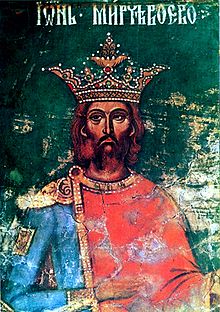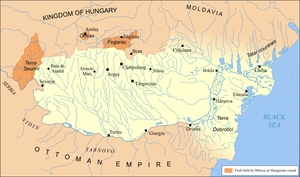- Mircea I of Wallachia
-
Mircea the Elder Voivode of Wallachia 
Mircea the ElderReign 1386–1418 Romanian Mircea cel Bătrân Born 1355 Birthplace Wallachia Died 1418 Place of death Wallachia Buried Cozia Monastery Predecessor Dan I Successor Michael I Consort Maria (possibly a Lackovic) Offspring Mihail I, Vlad Dracul, Radu II Chelul Royal House House of Basarab Father Radu I Mother Calinica Mircea the Elder (Romanian: Mircea cel Bătrân pronounced [ˈmirt͡ʃe̯a t͡ʃel bəˈtrɨn]; 1355–1418) was ruler of Wallachia from 1386 until his death. The byname "elder" was given to him after his death in order to distinguish him from his grandson Mircea II ("Mircea the Younger"). Starting in the 19th century, Romanian historiography has also referred to him as Mircea the Great (Romanian: Mircea cel Mare).[1]
Contents
Family background and heirs
Mircea was the son of voivode Radu I of Wallachia and Lady Calinica, thus being a descendant of the House of Basarab.[2] He was the father to Vlad II Dracul and grandfather of Mircea II, Vlad the Impaler (Dracula), Vlad Călugărul and Radu the Handsome. All of these would at one time or the other rule Wallachia, with Mircea II and Vlad Ţepeş both being able military commanders (the latter would eventually become one of the most notorious leaders in history, and the inspiration for the novel Dracula by Bram Stoker).
Historical importance
Mircea's reign is often considered to have brought stability to Wallachia. Found in a volatile region of the world, this principality's borders constantly shifted, but during Mircea's rule, Wallachia controlled the largest area in its history: from the river Olt in the north to the Danube in the south, and from the Danube's Iron Gates in the west to the Black Sea in the east.[3]
Mircea strengthened the power of the state and organized the different high offices, promoted economic development, increased the state's revenue, and minted silver money that enjoyed wide circulation not only inside the country but also in neighboring countries. He gave the merchants of Poland and Lithuania trade privileges and renewed those his predecessors had given to the people of Braşov. As a result, Mircea was able to afford increasing his military power. He fortified the Danube citadels and strengthened "the great army" made up of townspeople and of free and dependent peasants. He also proved to be a great supporter for the Church.[4]
While organizing the country and its institutions, Mircea also formed a system of lasting alliances which enabled him to defend the independence of the country. Through the intermediary of Petru Muşat, the prince of Moldavia, he concluded a treaty of alliance with Władysław II Jagiełło, king of Poland in 1389. The treaty was renewed in 1404 and 1410. He maintained close relations with Sigismund of Luxembourg, the king of Hungary, relying on their common interest in the struggle against Ottoman expansion.[5]
Conflicts with the Ottoman Empire
His interventions in support of the Bulgarians south of the Danube who were fighting against the Turks brought him into conflict with the Ottoman Empire. In 1394 Beyazid I (also known as "Yıldırım Beyazıt", "the Thunderbolt") crossed the Danube river, leading 40,000 men, an impressive force at the time. Mircea had only about 10,000 men so he could not survive an open fight. He chose what today we would call guerrilla warfare by starving the opposing army and utilizing small, localized attacks and retreats (a typical form of asymmetric warfare). On October 10, 1394, the two armies finally clashed at the Battle of Rovine, which featured a forested and swampy terrain, thus preventing the Ottomans from properly spreading their army; Mircea finally won the fierce battle and threw the Ottomans out of the country. Giurescu, pp. 367. This famous battle was later epically described by the poet Mihai Eminescu in his Third Epistle. However, Mircea had to retreat to Hungary, while the Turks installed Vlad Uzurpatorul on the throne of Wallachia.
In 1396 Mircea participated in an anti-Ottoman crusade started by Hungary's monarch. The crusade ended with the Ottoman victory at the Battle of Nicopolis on September 25. In the next year, 1397, Mircea, having defeated Vlad the Usurper with Hungarian help, stopped another Ottoman expedition that crossed the Danube, and in 1400 he defeated yet another expedition of Turks crossing the country.Giurescu, pp. 368.
The defeat of Sultan Beyazid I by Timur Lenk (Tamerlane) at Ankara in the summer of 1402 opened a period of anarchy in the Ottoman Empire and Mircea took advantage of it to organize together with the Hungarian king a campaign against the Turks. In 1404 Mircea was thus able to impose his rule on Dobrogea again. Moreover, Mircea took part in the struggles for the throne of the Ottoman Empire and enabled Musa to ascend that throne (for a brief reign). It was at this time that the prince reached the height of his power.Giurescu, pp. 369
Towards the end of his reign, Mircea signed a treaty with the Ottomans; in return for a tribute of 3,000 gold pieces per year, the Ottomans desisted from making Wallachia a province ("pashalik").Giurescu, p. 370.
Cultural importance
The "bravest and ablest of the Christian princes", as he was described by German historian Leunclavius, ruled Wallachia for 32 years. Apart from his military successes Mircea was an art lover, leaving us among other monuments beautiful Cozia Monastery, built after the model of the Krusevac Church (Krusevac) in Serbia.
In popular culture
Film
Mircea was played by Sergiu Nicolaescu in the 1989 film Mircea, which was also directed by Nicolaescu.
Notes
References
- (Romanian) Bogdan Petriceicu Hasdeu, Istoria critică a românilor, vol. I, Bucharest, 1875
- (Romanian) A. D. Xenopol, Istoria românilor din Dacia Traiană, vol. I, Iaşi, 1889
- (Romanian) Nicolae Iorga, Studii şi documente cu privire la istoria românilor, vol. III, Bucharest, 1901
- (Romanian) Constantin C. Giurescu, Istoria Românilor, vol. I, Bucharest, 1938
Preceded by
Dan IPrince of Wallachia
1386–1394/1395Succeeded by
Vlad I Uzurpatorul
(The Usurper)Preceded by
Vlad I Uzurpatorulrestored as
Prince of Wallachia
1397–1418Succeeded by
Mihail ICategories:- Rulers of Wallachia
- Christians of the Crusade of Nicopolis
- 1355 births
- 1418 deaths
- History of Romania
Wikimedia Foundation. 2010.


